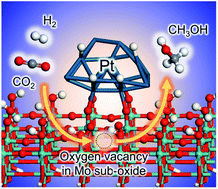A quasi-stable molybdenum sub-oxide with abundant oxygen vacancies that promotes CO2 hydrogenation to methanol†
Abstract
Production of methanol from anthropogenic carbon dioxide (CO2) is a promising chemical process that can alleviate both the environmental burden and the dependence on fossil fuels. In catalytic CO2 hydrogenation to methanol, reduction of CO2 to intermediate species is generally considered to be a crucial step. It is of great significance to design and develop advanced heterogeneous catalysts and to engineer the surface structures to promote CO2-to-methanol conversion. We herein report an oxygen-defective molybdenum sub-oxide coupled with Pt nanoparticles (Pt/HxMoO3−y) which affords high methanol yield with a methanol formation rate of 1.53 mmol g-cat−1 h−1 in liquid-phase CO2 hydrogenation under relatively mild reaction conditions (total 4.0 MPa, 200 °C), outperforming other oxide-supported Pt catalysts in terms of both the yield and selectivity for methanol. Experiments and comprehensive analyses including in situ X-ray absorption fine structure (XAFS), in situ diffuse reflectance infrared Fourier transform (DRIFT) spectroscopy and density functional theory (DFT) calculations reveal that both abundant surface oxygen vacancies (VO) and the redox ability of Mo species in quasi-stable HxMoO3−y confer the catalyst with enhanced adsorption and activation capability to subsequently transform CO2 to methanol. Moreover, the Pt NPs act as H2 dissociation sites to regenerate oxygen vacancies and as hydrogenation sites for the CO intermediate to finally afford methanol. Based on the experimental and computational studies, an oxygen-vacancy-mediated “reverse Mars–van Krevelen (M–vK)” mechanism is proposed. This study affords a new strategy for the design and development of an efficient heterogeneous catalyst for CO2 conversion.

- This article is part of the themed collection: Most popular 2021 catalysis articles, 2021


 Please wait while we load your content...
Please wait while we load your content...